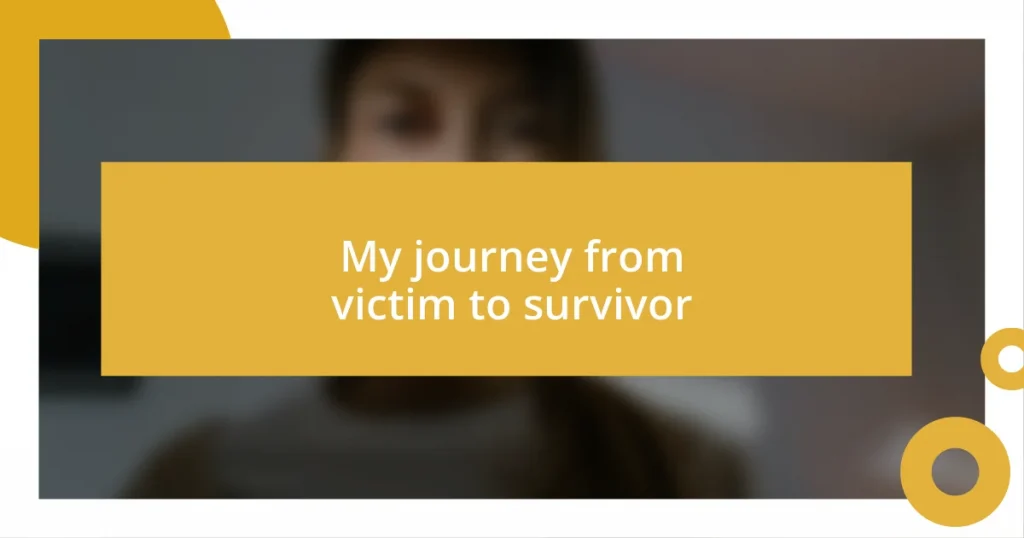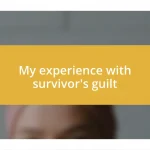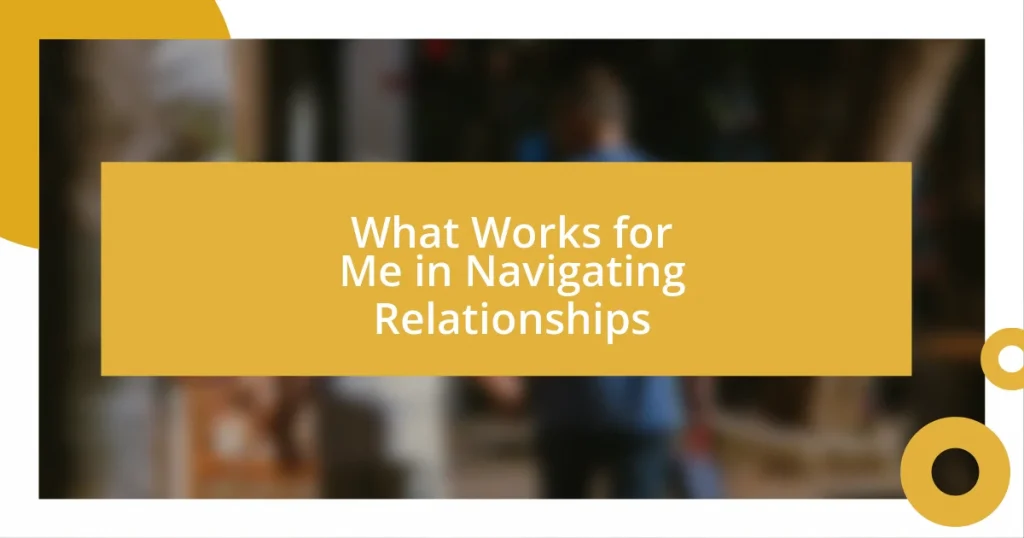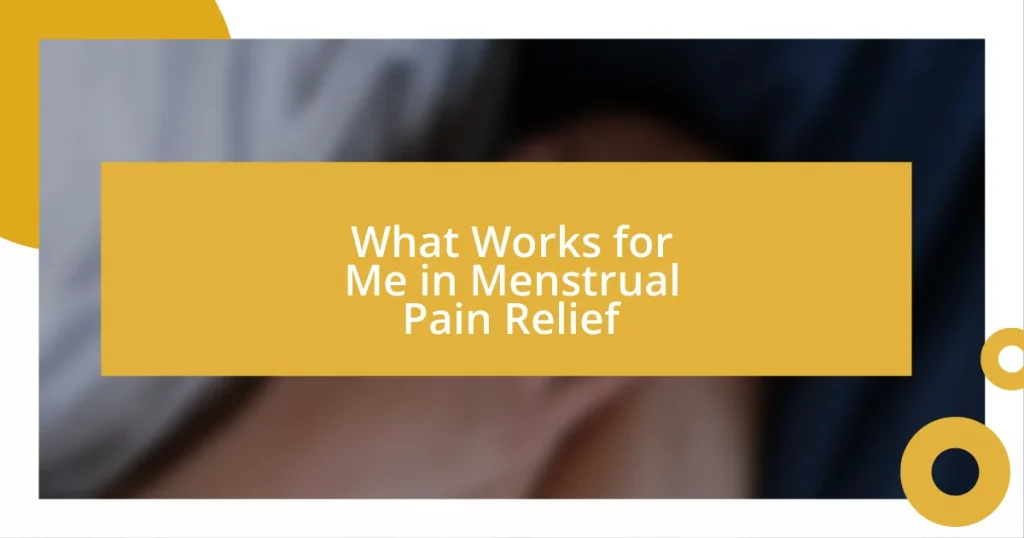Key takeaways:
- Shifting from a victim mindset to empowerment involves deep introspection and embracing vulnerability, leading to personal narrative reclamation.
- Developing a support system and coping mechanisms, such as journaling and setting boundaries, is vital for emotional healing and resilience.
- Continuing personal growth through exploring new interests and community connections reinforces the journey from survival to flourishing.

Understanding the Victim Mindset
The victim mindset often seeps into our thoughts in subtle, yet profound ways. I remember a time when I felt like life was happening to me, not for me. It’s almost like wearing a pair of blinders, where you can only see the obstacles and challenges, while all the potential for growth and change feels utterly out of reach.
When my perspective shifted, I realized that many of my emotions stemmed from a sense of powerlessness. Have you ever felt trapped in your circumstances, as if every decision was made for you? I can vividly recall moments when I let fear dictate my choices, believing I had no control over my future.
Understanding this mindset requires deep introspection. It’s about recognizing how we cling to our roles as victims because it feels safe, even when it doesn’t serve us. I’ve learned that embracing vulnerability is a courageous step towards breaking free, a crucial moment when I decided to reclaim my narrative rather than allowing past experiences to define me.

Recognizing the Path to Healing
Recognizing the path to healing is often the first courageous step toward true recovery. I remember when I finally acknowledged the pain I had been carrying; it felt like an immense weight lifted off my shoulders. I realized healing isn’t just about moving on; it’s about genuinely processing my emotions and understanding their impact on my life.
As I navigated through my healing journey, I found that recognizing my triggers became crucial. I started keeping a journal to document my feelings and set intentions for each day. It was in this daily practice that I learned to differentiate between my past traumas and present reality, a process that helped me reclaim my identity. Have you ever experienced a moment of clarity that changed everything? Finding those moments is what truly fosters healing and growth.
In my experience, recognizing the path to healing requires surrendering to the process. It’s not always linear, and there’s no universal timeline. There were days when I felt like I was moving backward, but those setbacks often taught me invaluable lessons about resilience. Choosing to honor my feelings, rather than suppress them, ultimately paved the way for a more authentic and fulfilling life.
| Previous Mindset | Recognized Healing Path |
|---|---|
| Feeling powerless | Empowerment through acknowledgment |
| Suppressing emotions | Embracing vulnerability |
| Lack of clarity | Finding moments of insight |

Building a Support System
Building a support system was a game-changer for me. In the beginning, I hesitated to reach out, fearing judgment or misunderstanding. However, as I began to share my experiences, I discovered the power of connection. My friends and family offered not just emotional support, but also practical advice and encouragement that helped me navigate through tough times. Each conversation not only validated my feelings but also reminded me that I wasn’t alone in this journey.
Creating a support system involves intentional steps:
- Identify trusted friends or family members you can confide in.
- Join support groups, whether online or in-person, where you can share your story.
- Seek professional help from therapists or counselors who specialize in trauma.
- Cultivate relationships with those who inspire you and foster positive energy.
- Engage in community activities or volunteer work to connect with like-minded people.
These actions helped me build a network that uplifted me when I stumbled, making the path from victim to survivor much more manageable. I can’t stress enough how crucial it is to surround yourself with people who truly understand your journey.

Developing Coping Mechanisms
Developing coping mechanisms is essential for anyone striving to move from victimhood to survival. Personally, I found grounding techniques particularly effective during moments of overwhelming anxiety. For instance, when I felt fear creeping in, I’d take a few deep breaths and focus on the sensations in my body—this simple act brought me back to the present, allowing me to regain control. What about you? Have you ever used a physical action to help ground yourself during challenging times?
In my journey, I also experimented with creative outlets as a way to channel my emotions. Painting, writing, or even cooking became my sanctuary, providing a safe space to express everything I had bottled up. I remember a night when I poured my heart onto the canvas, and it felt like I was releasing years of pent-up feelings with every brushstroke. These moments or activities can be transformative, allowing us to reshape our trauma into something beautiful. Have you considered how creativity might play a role in your healing?
Maintaining a routine was another crucial coping mechanism for me. Establishing a daily schedule provided structure and predictability, which felt grounding in times of chaos. I made sure to include time for self-care, whether it was a quiet cup of tea in the morning or a walk in nature during the evening. These rituals helped reinforce my commitment to healing, reminding me that I’m capable of taking positive steps each day. So, what small rituals can you incorporate into your life to support your journey towards resilience?

Embracing Self-Empowerment Techniques
Embracing self-empowerment techniques has been a pivotal part of my healing journey. I’ll never forget the moment I stood in front of a mirror and declared my worth aloud. Initially, it felt awkward, but as I repeated affirmations like “I am strong” and “I am enough,” I could feel a shift in my mindset. Have you ever tried speaking kindness to yourself? It’s a small yet profound act that can reshape how we view our circumstances.
Another powerful technique was setting personal boundaries. This was tough for me at first because I often felt guilty for saying “no.” I learned that prioritizing my well-being wasn’t selfish; it was necessary. I distinctly remember when I turned down an invitation that would have drained my energy, choosing instead to recharge my spirit at home. That decision reinforced my autonomy, allowing me to reclaim control over my choices. What boundaries have you set to protect your emotional space?
I also found immense value in journaling my thoughts. Pouring my feelings onto paper became a therapeutic release, enabling me to track my growth over time. One evening, I revisited entries from months prior, and it struck me how far I had come—every word was a testament to my resilience. The act of reflection can be eye-opening, can’t it? In this way, you can celebrate even the smallest victories along your path to empowerment.

Sharing Your Story for Impact
Sharing your story can be one of the most empowering things you do on your journey from victim to survivor. I remember the first time I opened up about my experiences in a small support group. Sharing my truth not only lightened my emotional load, but I also noticed other members nodding along, resonating with my words. Isn’t it amazing how sharing can create connection and understanding?
There was also a moment when I decided to write an article about my journey. I hesitated at first, fearing judgment, but as I crafted each paragraph, I started to feel liberated. It felt like shedding the weight of silence. In sharing my journey, I hoped to inspire others to find their voice, too. Have you considered how your story might encourage someone? You never know who might be waiting to hear what you have to say.
I’ve learned that vulnerability is a powerful tool. Just the other day, I took part in a local workshop where participants shared their experiences. Listening to others and sharing my story created an atmosphere of trust. Each story was unique, yet there was so much overlap in our emotions. This act of sharing forged a sense of community, helping me realize that I wasn’t alone in my struggles. Have you thought about the impact your story could have on someone else? It’s astonishing how stepping into that vulnerable space can create waves of healing, not only for ourselves but for others as well.

Continuing the Journey of Growth
Continuing to grow after such a transformative experience is crucial. I remember when my mindset began to shift from merely surviving to truly flourishing. One day, I attended a workshop on personal development, and the keynote speaker shared a profound concept: “Growth is a choice.” It struck me how I had the power to decide my future, which led me to actively seek new opportunities for learning and healing. Have you ever felt that moment when realization hits you hard and suddenly everything feels possible?
As I embraced this journey, I started exploring new hobbies that excited me. I took up painting, an activity I had long buried under shame and doubt. Each brushstroke became not just an expression of creativity but a symbol of reclaiming parts of myself I thought were lost. This exploration allowed me to celebrate my individuality, demonstrating how pursuing passions can ignite personal growth. What hobbies or interests have you shelved, waiting for you to rediscover them?
Moreover, I learned the importance of seeking support from others who share similar paths. Joining a community group focused on growth not only provided new insights but also fostered genuine connections. I recall a poignant conversation with a fellow survivor who shared her fears about the future. As we discussed our dreams and setbacks, I felt an overwhelming sense of solidarity. I realized that continuing this journey isn’t just about individual efforts; it’s also about lifting each other up. Who in your life could you turn to for encouragement as you navigate your own path?














